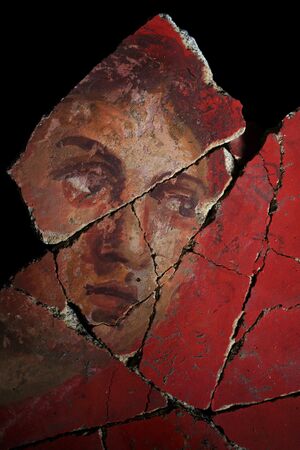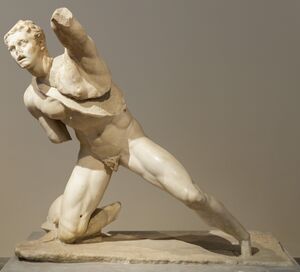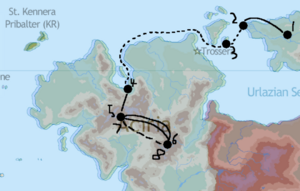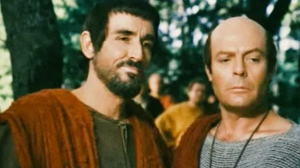Tazi ris me Rai
This article is non-canonical either because it refers to out-of-character content, the associated nations have left the region, or the information has been retconned. Accordingly, its content should not be considered to be part of the canonical structure of the region's lore.
|
| by Velcero | |
 Painting from the 19th century portraying Comia. | |
| Written | c. 6th century BC |
|---|---|
| Country | Aciriano-Istroyan Kingdom |
| Language | Glaistic |
| Genre(s) | Epic poetry |
The Tazi ris me Rai (Siege on the Gods), is a Glaistic epic poem composed somewhere in the 8th century BC. It is the first entry in the Arnirai saga (literally Walk of God). As the Glaistic people had no system of writing, it was passed on entirely by word-of-mouth before being written and recorded by Taineans in the 2nd century BC. It is the only recorded work of the Glaistic culture.
The epic is set around 2000 BC during the "Age of Heroes", and it follows the Glaistic hero Comia, who is the son of Cepa, the Glaistic god of fire, and a Glaistic woman. Comia's ancestry forces him into a battle against a high priest who has gone mad, and eventually stops the high priest from entering the sacred Golden City, the city of the gods.
Synopsis
First Arc
The poem begins with a description of events leading up to the chain of events. Cepa, the god of fire, notices a Glaistic woman once she was praying to him. Immediately enamored with her, he breaks the greatest taboo of the gods; he has an affair with the woman and impregnates her. Once he finds out that she gave birth to a demigod, Cepa quietly returns to the Golden City.
Cepa’s lies and worry eventually bleeds into the mind of a visas named Episapros who has visions of the Golden City. Episapros is driven mad by the sight of the Golden City; a sight mortals aren’t meant to see, and he embarks on a mission to enter the Golden City and join the gods.
Second Arc

As Comias grew, his temper became such a problem he was unable to work jobs in the community, forced to guard over the grazing cattle outside the village. On a day much like many others, Comias spotted a bearcub stalking the herd from the woods near the herd he was watching. Comias went after the cub to scare it away, following it all the way into the forest until it disappeared into seemingly thin air. He realized he was lost, and wandered the woods until he passed out from exhaustion, eventually waking up in a campsite with a cloaked stranger by the fire.
The stranger explained what luck Comias has, with the stranger finding him when he did. The stranger told of the mysterious cult heading for the direction he had fainted in, and quickly Comia was filled with worry; he begged and pleaded the stranger to help him get back to his village, and the stranger accepted. They returned to the village to find it burnt down; once Comias was filled with both sadness and anger, the stranger introduced himself as Orica, the god of vengeance. Orica proceeds to explain that the absent father of Comias was the god Cepa, making Comias a demigod, one of the children of the gods that Episparos and his cult needed to open the door to the Golden City. Orica offered both his blade capable of slaying gods, and assistance in seeking out revenge against Episparos, which Comias accepts and the two head out for the nearest port.
Third Arc
Arriving at the port settlement of Pauca, disguised Comias and Orica seek a sailor that would take them to the mainland. The two eventually found a captain named Dsuri who was willing to take them to the mainland after convincing him with the vast gold they could pay him with from the Golden City. Before dawn on the next day, the three set sail over the Restless Sea; but a terrible storm forced them to stop on the island of Rieca to wait for the weather on the seas to get better. Unfortunately for the trio, Episparos had felt the child of god on Rieca, personally leaving with cultists of his for the island to get his key. A fight with between the trio and Episparos and his cultists, with the heroes narrowly managing to escape into the slums of the island. Dsuri called off the deal after the narrow escape; the amount of gold he’s paid does not matter if he dies for it.
Comias, Orica and Dsuri go their different ways; Comias and Orica effectively stranded on the island now with only a matter of time when Episparos’ men find them. While looking for another captain in the slums, sounds of conflict catch their attention; Dsuri had met old crewmates of his who he had debts with. Orica insisted Comias allows the crewmates to get what was theirs, but despite this, Comias interfered. The crewmen harassing Dsuri then turned to strike Comias with his blade, and in an attempt to defend himself with his hands, he accidentally took advantage of his godly ancestry, with the thugs now ablaze after flames came out of his fingertips.
The selfless act of Comias paired with his now obvious powers convinced Dsuri to agree to their deal, and they left to sail for the mainland the next week. Dsuri knew of a pirate hideout named Utur further inland, insisting to take them there as opposed to the city of Elosa they wanted.
Fourth Act
Once arriving at the pirate hideout of Utur, they thanked Dsuri and parted ways with him. Dsuri suggested they spend some time at Utur due to all sorts of rumors circulating in the area can be found there. Taking his advice, Comias and Orica spent three days in the city. Comias already cursed Dsuri for wasting their time, but on the third day they heard travelers discussing mystics in the mountains that were able to open the door to the Golden City.
Ensuring no alternative entrances for Episparos was a priority, so the duo decided to take a detour through the mountains to visit this village and investigate the rumors. After listening in some more, they discovered that the village was hidden behind a wall of ice, which melts for an hour once a month. The approximate time was just a week away, so the two had to hurry; they’d have been late on foot, so they hid themselves in the cart of a merchant heading to the mountains.
In the mountains, they followed a path of ice that eventually brought them to a cave with a wall of ice before them. If they looked closely, they could see vague outlines of buildings behind the ice, so they made camp and waited. Two days and two nights passed by, but on the third day the sun hit the ice at such an angle, a hole just big enough for a man to squeeze through melted. They hurried on through and were greeted by an elderly high priest who spoke a very antiquated form of Glaistic, barely comprehensible to either Comias or Orica. They were brought further into the cave, which eventually opened up into a green valley. They had little time to admire its beauty, as they were brought before the visas archon known as Lucrax who inquired what the two were after. The high priest was seated next to a quiet young woman who seemed to listen to Comias’ explanation of their intentions more attentively than Lucrax himself. Lucrax laughed and informed no one is capable of such a feat, and told the two to leave in a month when the ice melted next.
As the days of the month went by, Comias noticed that the valley seemed to have no women. He had tried to ask the high priest about it, but the antiquated manner of speaking made it impossible for him to understand their explanations. Comias brought this up to Orica, who simply told him that ”there is a woman”. The reply was cryptic and left Comias disgruntled, but he continued investigating until the sun was the perfect angle. It was finally time for them to leave the valley.

Fifth Act
The months days had passed and Comias and Orica bid farewell to the visas inhabiting this valley. They ventured further down south towards Mount Ocot, the highest peak of the land where the door to the Golden City lied. Weeks of trekking through the confusing and cold mountains and avoiding the strange mystic-hunters that inhabited the highlands eventually resulted in them arriving at Mount Ocot. Their ascent was slow, but Orica encouraged Comias to push on as their mission was nearly at its end.
Episparos awaited them at the top of Mount Ocot. He proclaimed he had foreseen this and that the two were lucky to witness the ascendancy of a new god; before Comias had the chance to react, Episparos had cut his left hand off with a dagger made of ”sky-stone”. Comias collapsed to the floor and watched his removed hand glow, opening a golden door in thin air, with Episparos stepping in. With each step the ground grew blacker and blacker, and Orica charged in after him, shutting the door behind him before Comias lost consciousness.
While he laid unconscious, he saw terrible visions of the Golden City being corrupted and the gods withering away with it; the only thing keeping the evils of the Golden City from the human world was Oricas.
Once he came to, he knew he needed to find help. He didn’t know where, but he began wandering down the mountain, slowly noticing the sun never rose or set. Every day he wandered felt the same, since not a single streak of sunshine made an appearance for what he thought were weeks; eventually he collapsed, and lost consciousness again. He came to, eventually, once again at a campsite; this time, with a familiar face by the fire. Comias recognised her as the woman from the valley, who told that she had terrible nightmares of the Golden City before the neverending nights came. She had remembered what Comias and Orica spoke of to Lucrax, and had left the valley in search of them as soon as she could.
The woman introduced herself as Ulia, and explained that she herself wasn’t sure why she was at the valley; she was kept in the dark regarding her parents, only telling her that she was brought there as a child by her father. She also informed Comias of the plagues that would follow the neverending nights she had seen in her dreams; the two began to climb back up the mountain.
The weeks to the mountain top were even more challenging than last time due to the neverending night making it difficult to navigate. The length of the journey was doubled. At the top of the mountain, Ulia almost instinctively raised her hand which began to glow; the door to the Golden City opened, but the city was covered in vast darkness and rot. Comias and Ulia entered, and eventually found Episparos, who Comias fought and defeated with the blade Oricas had handed him prior. Ulia kneeled next to the lifeless body of Oricas, who soon drew a breath.
Ulia was revealed to be Taia in her human form; she had foreseen the events that unfolded long ago, leaving the seat of the gods vacant to stop herself from being affected by the corruption mortals bring there, and that Taia also sent Oricas to deliver her as a child to the valley before Oricas was to watch over Comias and guide him on his journey.
Geography

Almost as long as the story has existed, scholars have tried to speculate whether or not the locations described in the story are real, and if they are, where their geographical locations would be.
Despite the descriptions of geographic locations being left vague by the poet, the locations of the story have been interpreted as taking part in northern Vallos, other than Mount Ocot, which is located in the southern parts of Vallos. Specific routes for Comias’ and Oricas’ journey have been proposed to have started on eastern Vallos, and the Restless Sea is thought to be Kindreds Sea.
Themes
Revenge
Despite the good intentions of Oricas, and Taia, who had put him on this path, the story has been controversial for glorifying revenge. Comias’ motivation for embarking on his mission was not due to a sense of justice, but one of revenge, with little care for actually what was happening around him. Some have theorised that original intentions of the story were misinterpreted, with Oricas originally meant to be his brother, Teis.
Influence

The influence of the story for Vallosi culture cannot be measured, for it has been studied extensively for millenia by Vallosi scholars, authors and artists. Many Vallosi artists, especially 16th century onwards were inspired by the epic. These paintings were used to tell the story to the vast majority of the population that was illiterate, which then inspired further oral tradition by retelling of the story when the storyteller told things differently.
The earliest movies produced in Vallos were often inspired directly by the work. Works such as Counting the Days (1925) was a modern adaptation of the epic, while the widely praised and still widely loved movie adaptation from 1952 have been many Vallosis' first introductions to movies.